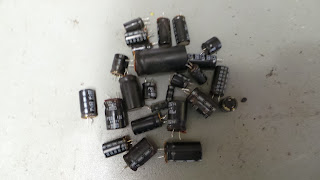It's a Ferguson 3629 "Personal" Television, using the Thorn 900 Chassis.
It's a compact set. The 900 chassis is often referred to as the "cool" chassis, designed to use less energy. It features no wasteful "dropper" resistor to obtain the correct voltages, but a mains auto transformer.
This particular set dates from 1965, and has the early valve UHF Tuner. Later models had a much improved transistor UHF tuner. The VHF Turret tuner can be seen on the right, the UHF tuner on the left. The UHF tuner has the valves enclosed in small screw-on caps.
Diminutive Mazda CME 1101 CRT
Red EHT rectifier tray. This is semi-conductor, and is mounted on top of the very reliable "jelly-pot" line output transformer.
The system switch can be seen running the whole length of the chassis. This is moved by a switch on the front panel, which moves a flexible cable, which in turn operates the system switch, and a switch on the VHF tuner.
Initial results are encouraging. Very poor frame linearity, and hold. Usually caused by a poor PCL805 or it's cathode decoupling. Not in this case, however! As usual, it was down to a capacitor on the secondary of the frame output transformer. Bob the bodger had previously been at work around the frame stage, and had fitted two replacement resistors (of the wrong value!) and a cap (of the wrong value!) After these were replaced, results on 405 lines were encouraging.
Initial results... poor linearity and frame lock.
UHF 625 operation was not good. Signals are available from my test rack at UHF channel 40, 50 and 60. In addition to signals on 36 and 68 from the house distribution system.
Reception on Ch 36 was OK, if a little grainy. Channel 60 was available strongly, although was extremely touchy to tune, and Channel 68 was good. Where are 40 and 50?
UHF tuner removed...
Valves inspected...
Fine tuning mech cleaned and lubricated. Be very careful not to move any wiring!
Apparently the small disc ceramic capacitor can crack, it's just to the left of the red coil... it's OK in this tuner.
It turns out that the PC88 is the guilty party!
Good pictures on 405....
... and 625. After a few minutes some hum starts to disturb the sound and picture.... It's pretty obvious a re-cap of the set will be required...
Quite a few caps are in physically poor condition, or electrically faulty and are replaced, along with the PC88....
The set then functions well, so I re-install the chassis into the cabinet. The set then suffers with intermittent frame collapse (no frame drive), leaving a horizontal line on the centre of the CRT....
 After much probing about with an insulated screwdriver, I spot something arcing on the scan coils...
After much probing about with an insulated screwdriver, I spot something arcing on the scan coils...... it's a thermistor (or rather was!). It's turned into a blob of something... I don't have a replacement (and I've got precious little chance of getting one), so I shorted it out, restoring operation.
And here's a video of the set working...





































